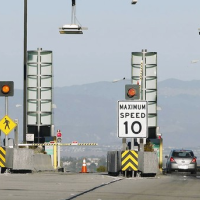Ill-Conceived Southern California Toll Roads Struggle to Survive
 Endangered toll plaza on the San Joaquin Hills toll road (photo: Don Leach, Daily Pilot)
Endangered toll plaza on the San Joaquin Hills toll road (photo: Don Leach, Daily Pilot)
Twelve years after the Orange County Transportation Authority (OCTA) unsuccessfully begged the state to buy its beleaguered private toll road system, state Treasurer Bill Lockyer is launching an inquiry into whether they are financially viable.
Bonds used to build the roads through Southern California’s San Joaquin Hills have been downgraded by Wall Street to junk, and those for the Foothill-Eastern corridor to a notch above. Multiple waves of refinancing have increased their cost and delayed a final payoff by a decade. The tolls have tripled and the roads are vastly underused.
Ridership on the San Joaquin Hills corridor in 2011 was 43% of the forecast made when the system was constructed in the 1990s, resulting in revenue that is only 61% of predictions. Instead of paying off the bonds by 2033, it will be 2042 before the debt is off the books and the highway is free. Foothill-Eastern traffic is 33% below projections. Meanwhile, the agency overseeing the roads has borrowed about $4.4 billion for them, but will have to make at least $10.5 billion in debt payments, according to financial statements seen by the Los Angeles Times.
In June, the Transportation Corridor Agencies announced that, in order to save money, manned toll booths on the San Joaquin would be replaced by the non-cash electronic FasTrak system over a 16-month period. And fares were raised for the 12th time since fiscal year 1997.
Despite their financial problems, or perhaps because of them, an effort was made to extend the Foothill-Eastern corridor through the heart of the San Onofre State Beach, threatening endangered species, reducing available recreation space and impacting training exercises at the U.S. Marine Corps base at Camp Pendleton. The California Coastal Commission rejected the plan and the U.S. Department of Commerce concurred.
The Orange County toll roads were built using an innovative public-private model that offered hope to those seeking new ways to finance roads in California. Toll roads have been used in other states for years, especially on the East Coast. Their proponents tout privatization as more efficient than public control and a way for cash-strapped governments to tap marketplace capital for infrastructure projects.
Opponents argue that it is double taxation for a driver to pay tolls in addition to gasoline taxes, privatization creates a two-tier system that provides more traditional public services (like transportation) for wealthy people, and transportation policy should be determined by long-term public policy considerations, not short-term corporate profits.
In May 2000, about the same time the Orange County Transportation Authority voted 10-1 to get rid of the toll roads, then-Assemblywoman Marilyn Brewer, a Newport Beach Republican, pushed for a failed bill that would lay the groundwork for the state buying the nearby 91 Express Lanes. But she thought it wouldn’t be feasible to buy the other roads.
Brewer, who is given credit for prompting the Lockyer review, sounds more proactive now. “I think they are in trouble,” she told the Times. “I don’t believe there is malfeasance, but it’s no way to run a railroad or a toll road.”
–Ken Broder
To Learn More:
Orange County Toll Roads under Review by California (by Dan Weikel, Los Angeles Times)
Toll Roads to Lay Off Attendants, Stop Taking Cash (by Mike Reicher, Daily Pilot)
O.C. to State: Buy Our Toll Roads (by Meg James, Los Angeles Times)
- Top Stories
- Controversies
- Where is the Money Going?
- California and the Nation
- Appointments and Resignations
- Unusual News
- Latest News
- California Forbids U.S. Immigration Agents from Pretending to be Police
- California Lawmakers Urged to Strip “Self-Dealing” Tax Board of Its Duties
- Big Oil’s Grip on California
- Santa Cruz Police See Homeland Security Betrayal in Use of Gang Roundup as Cover for Immigration Raid
- Oil Companies Face Deadline to Stop Polluting California Groundwater





